LP 33/2019 A Summary of 108 Maritime Incident Investigation Reports
Maritime incident reports, as firsthand materials, play a decisive role in liability distributions. Based on 108 investigation reports made public by China MSA in recent years, this summary is prepared to thoroughly discuss reasons behind the collisions so that lessons can be learnt, and preventive measures taken.
I. Relevant Legislation and Guidance
Effective as of 26 December 2005, Minutes of the Second National Working Conference on the Trial of Foreign-Related Commercial and Maritime Cases by the Supreme People’s Court of RPC provides that after the occurrence of a ship collision incident, the investigation materials obtained by the relevant competent authority, which have been confirmed by parties involved in such maritime incident, may serve as the evidence for the relative maritime court to ascertain the facts of the incident if there is no evidence to the contrary.
The Guidelines for Maritime Incident Investigation and Maritime Affair Trials [MSA-2015-03081] provides that investigation reports and its concluding recommendations may serve as evidence for litigation in the trial of the maritime court unless disproved by sufficient factual evidence and justifications.
Other applicable laws and regulations for identifying liabilities include:
· International Regulations for Preventing Collisions at Sea (COLREG 1972)
· Maritime Traffic Safety Law of the People’s Republic of China 1984
· Regulations of the People’s Republic of China on the Investigation and Handling of Maritime Traffic Accidents 1990
· Regulations on Handling Maritime Hit and Run Collisions [2011] 716
· Local regulations such as Routing Scheme for Vessels in Shanghai Section of the Yangtze River
Generally, the party that should take more blame for the incident will be specified in the investigation report, but the actual proportion of liability (at least 5%) will be determined by the maritime court according to the degree of fault after both parties assuming the burden of proof. The report not only helps to attribute blame, but is also a good reference for shipowners to prevent future incidents.
II. Classification and Analysis
1. By types of vessel

Among the 108 incident reports selected, 53 cases – almost 50% were between commercial vessels and fishing vessels, most frequently in Ningbo-Zhoushan waters where fishery thrives. Navigating officers are advised to steer clear of fishing areas when planning voyages and warn the fishing vessels away when encountering them by exhibiting prescribed sound and light signals. Cautions should be exercised and the engine be ready for shifting course and speed at any point. Stop the ship to avoid them in extreme cases.
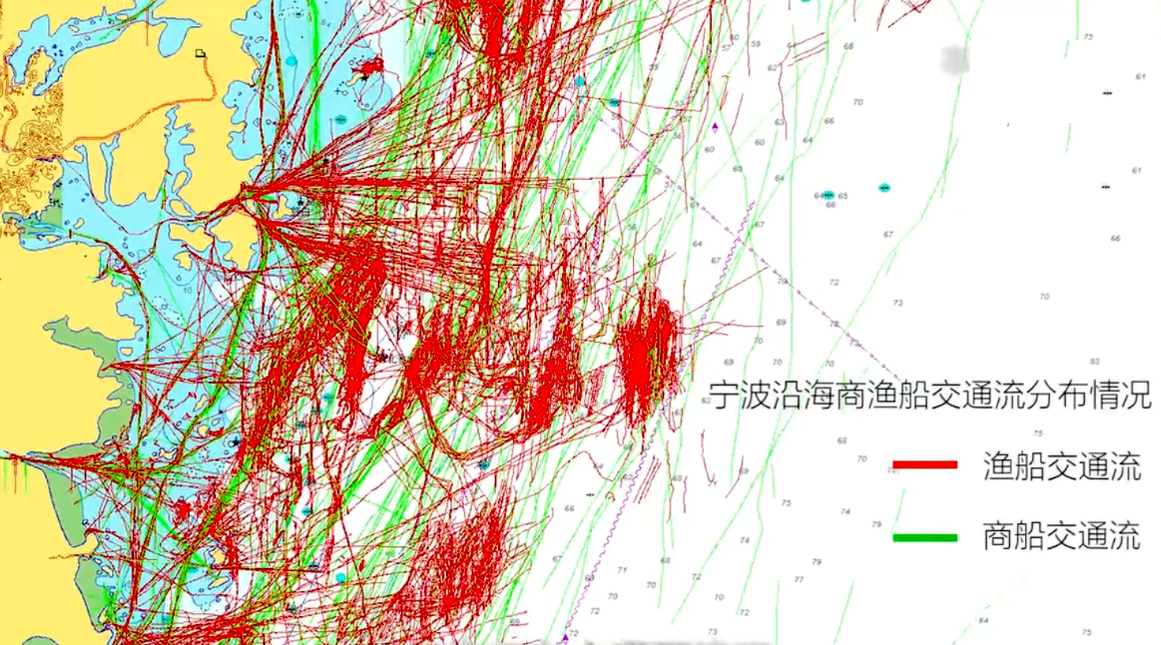
2. By types of casualty
All vessels in the 108 reports were subject to different degrees of damage. Among them, ships were sunk in 69 cases and personnel missing or dead were reported in 52 cases. Such incidents incur not only risks of pollution, wreck removal and cargo damage, but also great loss and suffering in families.
3. By time of occurrence
More than half of the 108 collision incidents happened when the second officer was on duty. Time period from 8:00 p.m. to midnight, from midnight to 4:00 a.m. and from 4:00 a.m. to 8:00 a.m. see the largest number of incidents, totally 83 cases. The highest incident frequency was found between midnight and 4:00 a.m. with the second officer on watch.
4. By situations
Collisions happen mostly in a crossing situation, and secondly to vessels dragging anchor and those at berth, 29 and 21 cases respectively. Next on the list are vessels navigating in areas of restricted visibility and in a narrow channel, 19 and 9 cases respectively. 8 cases were collision with vessels engaged in fishing. 6 cases happened in a traffic separation line and 5 in an overtaking situation.
5. By types of fault
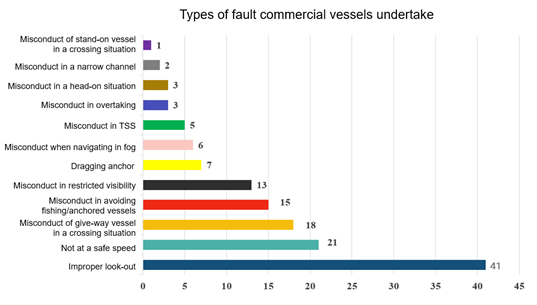
Shipowners will be put at a disadvantage if commercial vessels are to undertake major responsibilities, the reasons behind which are always complicated. Among the 108 cases, 99 of them were partially because of the crew’s negligence on look-out; 50 vessels involved were not navigating at a safe speed; misconduct of give-way vessel was found in 33 cases.
Although incidents were occasionally caused by environmental or technical issues, it’s human fault that contributes the most. Targeted actions should be taken in daily operations in view of the analysis. Hopefully, with the COLREGs in mind and training carried out to improve navigational watchkeeping practice and situational awareness, seafarers will see fewer of such incidents.
III. Case Study
In this chapter, three cases are selected to look into what has happened. Through ascertainment of the causes and circumstances, safety lessons can be learnt.
1. Collision between SP and ZXY 05885
Ship Particulars | ||
Vessel’s name | SP | ZXY 05885 |
Type | Bulk carrier | Fishing vessel |
Gross tonnage | 40,489 | 240 |
Marine Casualty Information | ||
Date and time | 29 October 2014 at 2340 | |
Location of incident | 30°49’N 123°57’E, East China Sea | |
Damage | Deformation to the bow | Vessel lost |
Injuries/fatalities | None | 13 missing, 2 rescued |
Situation | Give-way vessel in a crossing situation | Stand-on vessel in a crossing situation |
Weather and environment | Cloudy Wind: E winds 15-20 knots Wave height: 1.5-2 m Visibility: 8 nm | |
Applicable rules | COLREG Rule 5, 6, 7.1, 8.5, 16, 17.3 Maritime Traffic Safety Law of PRC Clause 37, 42 | |
Cause of collision | Rules to avoid collision not properly followed | |
Fault of both parties | l Proper look-out not maintained l Did not proceed in a safe speed l Inaccurate assessment on the circumstance l Action to avoid collision by reducing speed or stopping not taken |
In the circumstances involving the risk of collision, altered her course to port for SP on her own port side |
Liability distribution | Primary | Secondary |
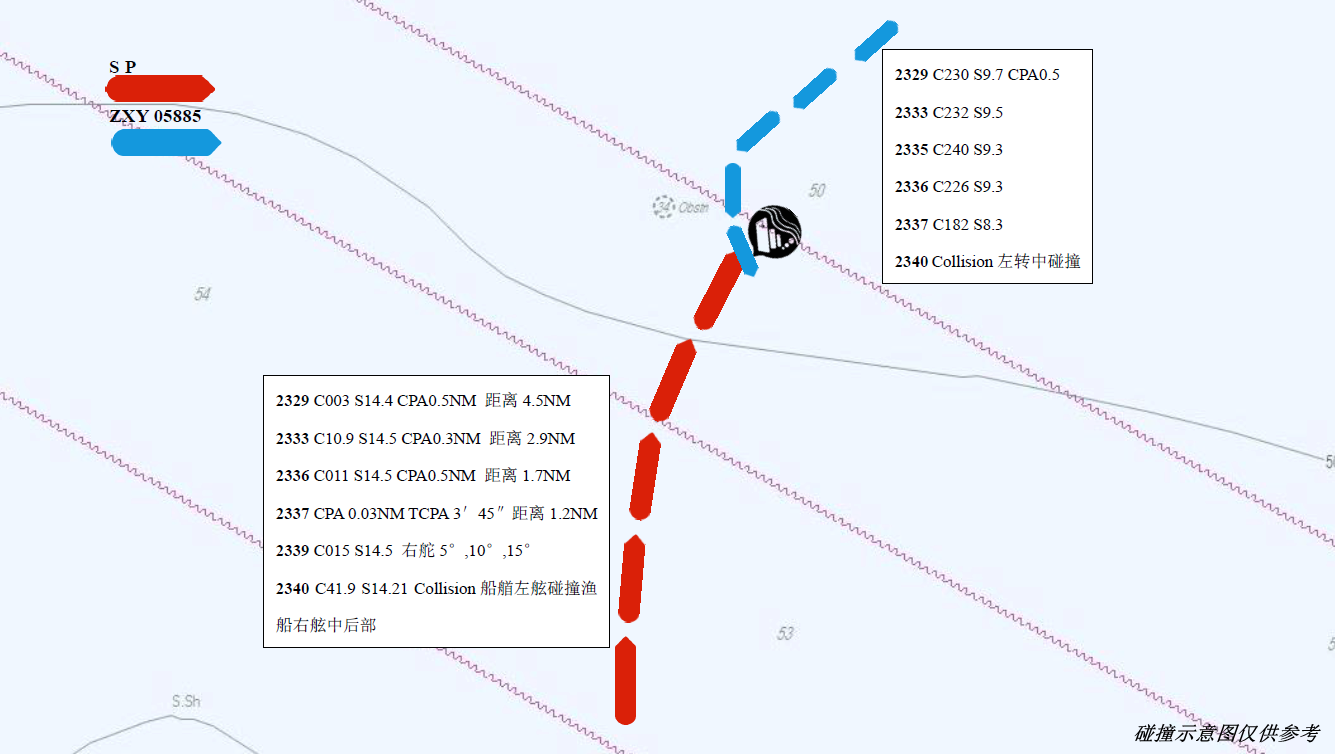
2. Collision between XR6 and LXY 60968
Ship Particulars | ||
Vessel’s name | XR6 | LXY60968 |
Type | Bulk carrier | Fishing vessel |
Gross tonnage | 7,235 | 168 |
Marine Casualty Information | ||
Date and time | 27 February 2016 at 0040 | |
Location of incident | 35°35’N 120°57’E, 18 nm south of Chaolian Island, Qingdao, China | |
Damage | Damage to the bulb bow | Vessel lost |
Injuries/fatalities | None | 8 dead, 2 missing |
Situation | Restricted visibility | Restricted visibility |
Weather and environment | Cloudy, light fog Wind: N winds 15-20 knots Visibility: 2 nm | |
Applicable rules | COLREG Rule 5, 6, 7.2, 7.3, 8.1, 8.4, 8.5, 19, 35 | |
Cause of collision | XR6 altered to port for LXY on her port side and was mistakenly left hard to starboard while LXY turned her course to starboard. Collision happened as a result of poor management and coordination, plus the fishing vessel was undermanned. | |
Fault of both parties | l Proper look-out not maintained l Did not proceed in a safe speed l Scant vigilance in fog l Action to avoid collision by not properly taken | l Proper look-out not maintained l Action to avoid collision by not properly taken |
Liability distribution | Primary | Secondary |
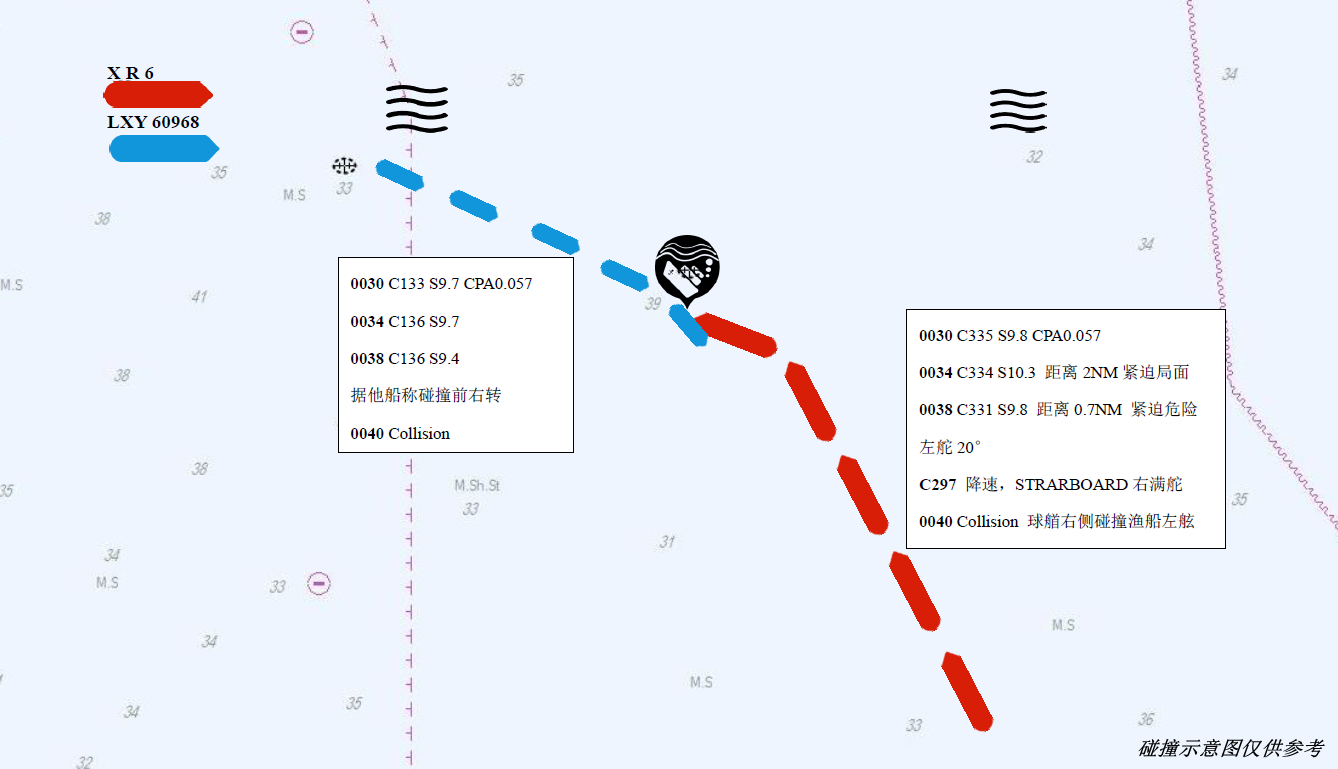
3. Collision between VC and ZXY 13016
Ship Particulars | ||
Vessel’s name | VC | ZXY 13016 |
Type | Bulk carrier | Trawler |
Gross tonnage | 43,507 | 135 |
Marine Casualty Information | ||
Date and time | 13 December 2015 at 2029 | |
Location of incident | 30°07’N 123°01’E, Zhoushan, China | |
Damage | Structural damage | Vessel lost |
Injuries/fatalities | None | 3 missing |
Situation | Give-way vessel in a crossing situation | Engaged in trawling in a crossing situation |
Weather and environment | N winds 20-25 knots Northwest drift at 2 knots Visibility: good | |
Applicable rules | COLREG Rule 5, 7, 18.1.3, 26 Maritime Traffic Safety Law of PRC Clause 37 | |
Fault of both parties | l Proper look-out not maintained l Did not keep out of the way of the fishing vessel l Left the site afterwards without performing search and rescue | l Proper look-out not maintained l Did not exhibit the lights as prescribed
|
Liability distribution | Primary | Secondary |
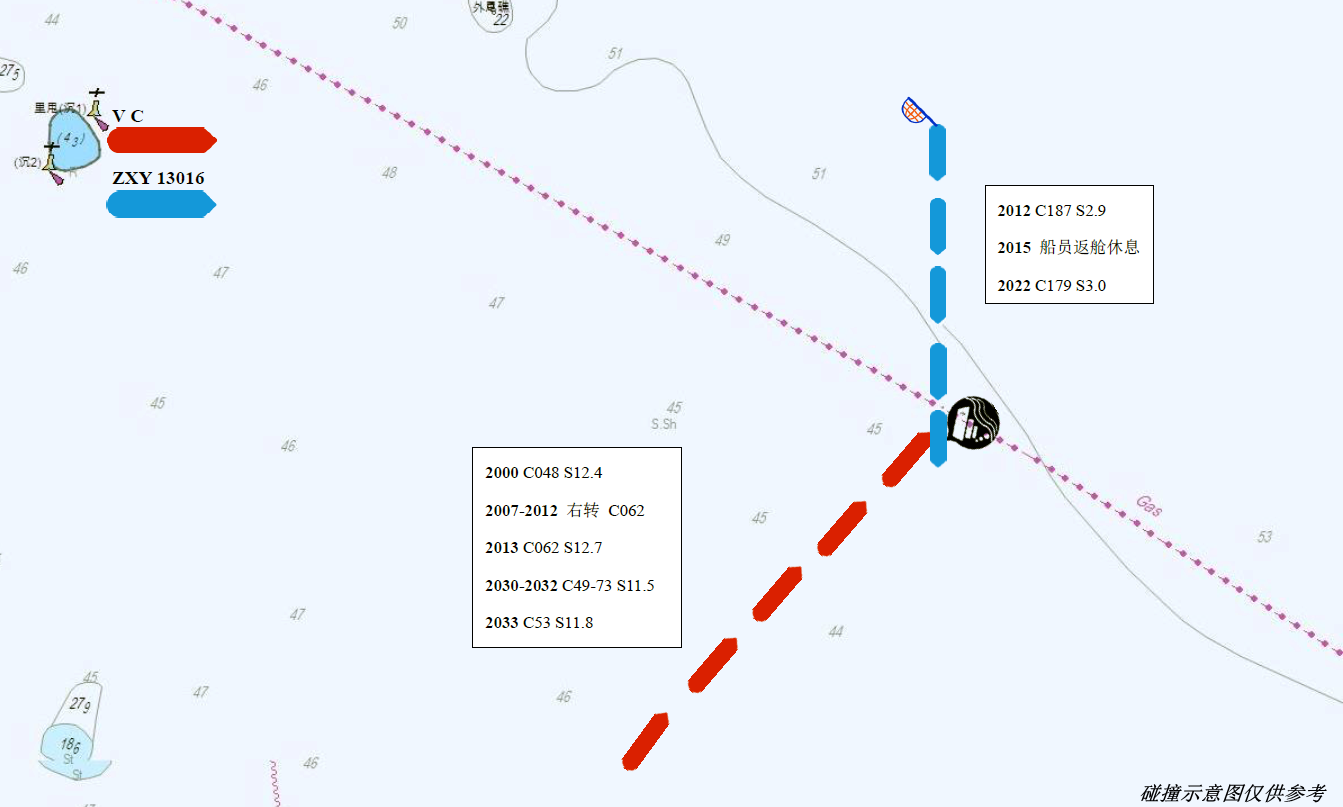
It’s always easy to look at a collision incident when it happened to someone else. What confronts shipmasters and seafarers in real life scenario can be much more complicated. Our recommendation is to get familiar with the COLREGs and local regulations, evaluate the situation based on practical experience and skillful operation of aids-to-navigation, and take early and substantial action to keep well clear as far as possible. And for ship companies, it’s of utmost importance to implement safety management system and carry out regular training and drills. At the end of the day, it’s our earnest hope that all ships sailing can return home safe and sound.
For further information, please contact your manager at the Club.
